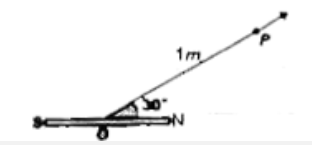Oxygen molecule is paramagnetic in nature . What is the paramagnetic content in terms of magnetic moment is O−2 ? (a) 1.732 (b) 3 (c) 1.5 (d) 2.5
1.732
3
1.5
2.5
The correct Answer is:A
To determine the paramagnetic content in terms of magnetic moment for the O2^- ion, we can follow these steps:
1. Understanding the Electronic Configuration of O2:
- The molecular oxygen (O2) has 16 electrons. Its electronic configuration can be represented as:
- σ(1s)², σ*(1s)², σ(2s)², σ*(2s)², σ(2p_z)², π(2p_x)², π(2p_y)², π*(2p_x)¹, π*(2p_y)¹
- The two unpaired electrons are in the π* (2p) antibonding orbitals.
2. Understanding the Electronic Configuration of O2-:
- The O2^- ion has 17 electrons. The additional electron will occupy one of the π* orbitals:
- σ(1s)², σ*(1s)², σ(2s)², σ*(2s)², σ(2p_z)², π(2p_x)², π(2p_y)², π*(2p_x)¹, π*(2p_y)², π*(2p_x)¹
- Now, O2^- has one unpaired electron in the π* orbital.
3. Calculating the Magnetic Moment (μ):
- The magnetic moment (μ) can be calculated using the formula:
μ=√n(n+2)
- Where n is the number of unpaired electrons. For O2^-, n=1.
4. Substituting the Value of n:
- Substitute n=1 into the formula:
μ=√1(1+2)=√1×3=√3
5. Calculating the Value:
- The numerical value of √3 is approximately 1.732.
6. Conclusion:
- Therefore, the paramagnetic content in terms of magnetic moment for O2^- is 1.732.
Final Answer:
The correct answer is (a) 1.732.
- The molecular oxygen (O2) has 16 electrons. Its electronic configuration can be represented as:
- σ(1s)², σ*(1s)², σ(2s)², σ*(2s)², σ(2p_z)², π(2p_x)², π(2p_y)², π*(2p_x)¹, π*(2p_y)¹
- The two unpaired electrons are in the π* (2p) antibonding orbitals.
- The O2^- ion has 17 electrons. The additional electron will occupy one of the π* orbitals:
- σ(1s)², σ*(1s)², σ(2s)², σ*(2s)², σ(2p_z)², π(2p_x)², π(2p_y)², π*(2p_x)¹, π*(2p_y)², π*(2p_x)¹
- Now, O2^- has one unpaired electron in the π* orbital.
- The magnetic moment (μ) can be calculated using the formula:
μ=√n(n+2)
- Where n is the number of unpaired electrons. For O2^-, n=1.
- Substitute n=1 into the formula:
μ=√1(1+2)=√1×3=√3
- The numerical value of √3 is approximately 1.732.
- Therefore, the paramagnetic content in terms of magnetic moment for O2^- is 1.732.
The correct answer is (a) 1.732.
Topper's Solved these Questions
- CHEMICAL BONDING & MOLECULAR STRUCTUREBOOK - NCERT FINGERTPS ENGLISHCHAPTER - CHEMICAL BONDING & MOLECULAR STRUCTUREEXERCISE - HIGHER ORDER THINKING SKILLS
10 Videos
- CHEMICAL BONDING & MOLECULAR STRUCTUREBOOK - NCERT FINGERTPS ENGLISHCHAPTER - CHEMICAL BONDING & MOLECULAR STRUCTUREEXERCISE - EXEMPLAR PROBLEMS
14 Videos
- CLASSIFICATION OF ELEMENTS AND PERIODICITY BOOK - NCERT FINGERTPS ENGLISHCHAPTER - CLASSIFICATION OF ELEMENTS AND PERIODICITY EXERCISE - Assertion And Reason
15 Videos
Similar Questions
Knowledge Check
Assertion : O2 molecule is diamagnetic while C2 molecule is paramagnetic in nature.
Reason : Bond order of O2 molecule is 1.5 and that of C2 molecule is 2.5 .AIf both assertion and reason are true and reason is the correct explanation of assertion.BIf both assertion and reason are true but reason in not the correct explanation of assertion.CIf assertion is true but reason is false.DIf both assertion and reason are false.Assertion: In vapour state sulphur is paramagnetic in nature.
Reason : In vapour state sulphur exists as S2 molecule.AIf both assertion and reason are true and reason is the correct explanation of assertion.BIf both assertion and reason are true but reason is not the correct explanation of assertion.CIf assertion is true but reason is false.DIf both assertion and reason are false.
The value of {2−3(2−3)3}3 is
(a)5
(b) 125
(c) 15
(d) −125
View SolutionA : Fe3O4 is ferrimagnetic at room temperature but becomes paramagnetic at 850 K.
R : The magnetic moment in Fe3O4 are aligned equally in parallel and antiparallel directions which on heating randomise.
View SolutionThe sum of the coefficients in the monomials 3a2b and −2ab2 is
View SolutionConvert each part of the ratio to percentage:
(a) 3:1
(b) 2:3:5
(c) 1:4
(d) 1: 2:5
View SolutionStatement-1: O3 reacts with KOH and forms a paramagnetic compound.
Statement-2: KO3 is paramagnetic.
Statement-3: O2 gives O−2 when heated with Na/NH3
View SolutionTransition metals and many of their compounds show paramagnetic behaviour where there are unpaired electron or electrons. The magnetic moment arises from the spin and orbital motions in ions or molecule. Magnetic moment of n unpaired electrons is given as
μ=√n(n+2) Bohr magneton
Magnetic moment increases as the number of unpaired electrons increases.
Q. Magnetic moment of [Ni(CN)4]2− is zero but that of [Ni(H2O)4]2+ is 2.83BM. is because of :
View Solution

